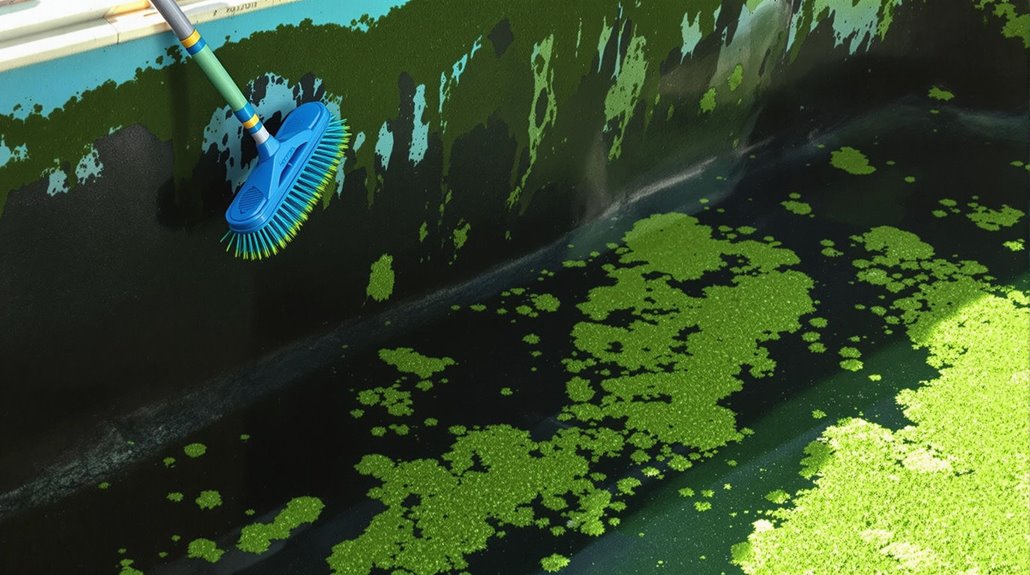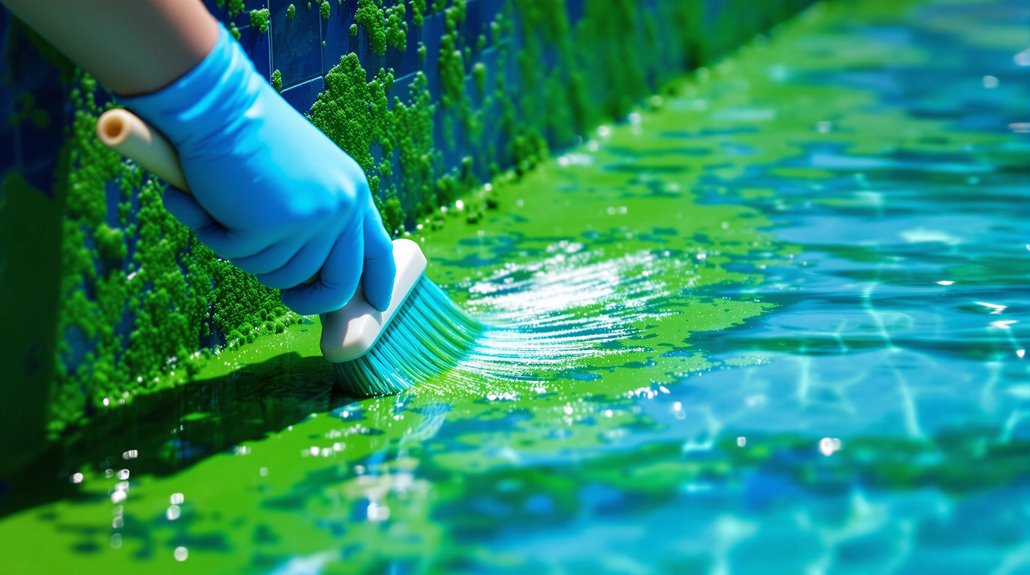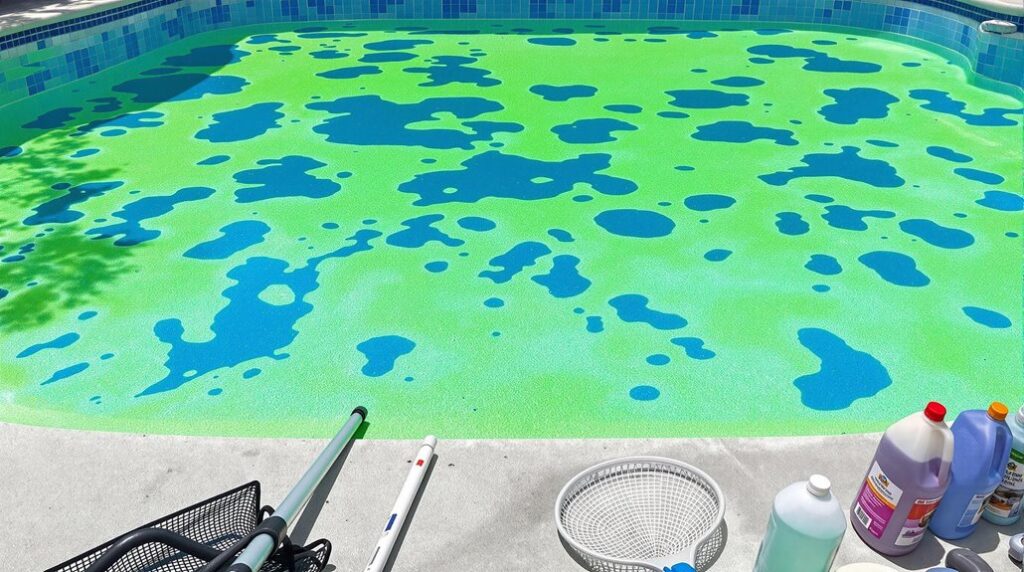To defeat pool algae, you’ll need to attack it systematically. Start by vacuuming debris and brushing all surfaces thoroughly. Test your water chemistry, adjusting pH to 7.1-7.3 and alkalinity to 100 ppm. Shock the pool with granular chlorine until you reach 30 ppm free chlorine levels. Maintain proper filtration by running your pump 8-12 hours daily. Follow up with preventive measures, including weekly algaecide treatments and regular surface maintenance, for long-term success.
Understanding Pool Algae Types and Their Causes

Pool algae can quickly transform your crystal-clear swimming pool into a murky, uninviting mess. Three main types can invade your pool: green, mustard, and black algae. Green algae is the most common, forming a slimy layer in poorly circulated areas as chlorine levels drop. Mustard algae creates stubborn yellow-brown patches in shaded spots, while black algae forms deep-rooted colonies that can damage your pool’s structure.
These unwanted guests typically appear at the start your pool’s chemistry isn’t properly balanced. Low chlorine levels, poor circulation, and improper pH levels create the perfect environment for algae to thrive. Spores enter through wind, rain, or contaminated pool equipment, then multiply rapidly in stagnant areas. Understanding these variants and their causes is your initial step toward maintaining a crystal-clear pool. A cloudy pool appearance often serves as the first warning sign that algae growth is beginning to take hold.
Essential Prevention Steps to Keep Algae Away
While maintaining a pristine pool requires consistent effort, preventing algae growth comes down to five essential areas of focus: water chemistry management, filtration optimization, preventive chemical treatments, surface maintenance, and environmental controls. Proper circulation management helps distribute chemicals evenly throughout your pool water for maximum effectiveness.
Keep your chlorine levels between 2.0-4.0 ppm and test your water 3-4 times weekly to maintain proper chemistry. Run your filter 8-12 hours daily, and don’t forget to replace those 60 µm cartridges when needed. Regular filter cleaning will significantly extend your equipment’s service life. If your pump starts making unusual noises, check for air in lines immediately to prevent circulation issues. Add weekly doses of algaecide and use phosphate removers to cut off algae’s food supply. Watch for water level drops as they could indicate a leak that affects chemical balance. Brush your pool walls weekly with stiff bristles, and vacuum debris regularly – especially after storms. Install a pool cover to block unwanted spores, and you’ll considerably reduce the chance of algae taking hold in your pool. Maintaining proper pH balance between 7.2 and 7.8 is crucial for your sanitizer’s effectiveness in preventing algae growth.
Step-by-Step Guide to Eliminating Existing Algae

Even the best-maintained pools can develop algae, but you’ll find it’s not difficult to eliminate with the right approach. The key is following a systematic process that addresses both visible algae and underlying water chemistry issues. Daily skimming helps remove debris before it sinks to the bottom and complicates algae treatment. Maintaining your pool heater efficiency through regular servicing will help ensure proper water circulation during treatment. Implementing year-round maintenance prevents most algae problems from developing in the first place. Chemical testing failures often indicate conditions that promote algae growth.
- Start by vacuuming your pool on the waste setting, moving slowly to avoid stirring up settled particles, while keeping the water level halfway up the skimmer
- Brush all surfaces thoroughly with the appropriate brush type – stainless steel for concrete pools, nylon for others – focusing on corners and crevices
- Test and adjust your water chemistry, bringing pH to 7.1-7.3 and alkalinity to 100 ppm
- Shock your pool with granular chlorine using 2-5 kg per 10,000 gallons to reach 30 ppm free chlorine level
Regular pool shocking helps prevent algae growth before it becomes a visible problem.
Long-Term Maintenance Strategies for an Algae-Free Pool
Maintaining an algae-free pool requires a thorough strategy that combines regular physical maintenance, proper chemical balance, and efficient filtration systems. You’ll need to vacuum and brush pool surfaces weekly, while skimming the surface daily to remove debris before it settles. Keep your pH between 7.2-7.6 and chlorine at 1.0-3.0 ppm, testing weekly with reliable kits. Starting your pool maintenance routine early in spring helps prevent algae problems before summer arrives. Regular tile scrubbing helps prevent algae from gaining a foothold on surfaces.
Run your pump 8-12 hours daily and backwash filters monthly to guarantee proper circulation. Don’t forget to shock your pool at night with calcium hypochlorite for maximum effectiveness. Install a pool cover to block sunlight and debris, and apply copper-free algaecides weekly as a preventative measure. Remember to sanitize pool equipment and toys before reintroducing them to prevent contamination, and maintain detailed records of your chemical adjustments to track patterns over time. Saltwater systems can be an effective alternative to traditional chlorine pools, offering more stable sanitization levels while being gentler on skin and eyes.
Frequently Asked Questions
Can I Swim in My Pool While Treating It for Algae?
Don’t swim in pools during algae treatment. Wait 24-48 hours after treatment due to:
- High chemical levels
- Bacterial risks
- Unbalanced water chemistry
How Long After Shocking the Pool Should I Wait to Swim?
Wait 8-24 hours after chlorine shock; 15 minutes after non-chlorine shock. Test before swimming; chlorine must be below 5 ppm.
Will Heavy Rain Affect My Algae Treatment Process?
Heavy rain disrupts algae treatment by diluting chemicals and adding algae-feeding nutrients. Re-shock pool and rebalance chemicals after rainfall.
Do I Need to Replace My Filter After a Severe Algae Outbreak?
Clean filter thoroughly and inspect for damage. Test filter performance against normal readings to decide if replacement needed.
Can Pool Algae Make My Pets Sick if They Drink the Water?
Pool algae can be toxic to pets, causing vomiting, seizures, and liver failure. Prevent pets from drinking pool water and contact a vet if ingestion occurs.

